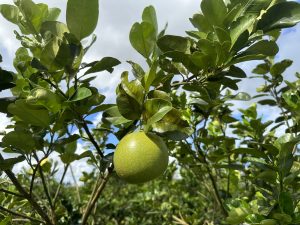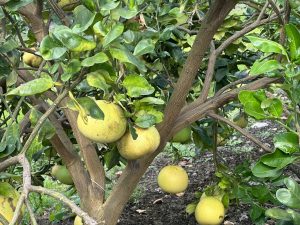Florida citrus growers and researchers arrived from Davie, Bartow, Lakeland, Plant City, Fellsmere and Gainesville to view more than 5,500 trees of several new citrus varieties. Some of the trees are showing initial tolerance to citrus greening.
The occasion was the Millennium Block Drive-Thru at the University of Florida Institute of Food and Agricultural Sciences (UF/IFAS) Indian River Research and Education Center (IRREC) in Fort Pierce.
“Tour visitors saw that some trees are much healthier than others,” said IRREC Director Ronald Cave. “Our research will continue for the next few years. Then we will publish recommendations for the industry.”
Flavia Zambon, assistant professor of horticultural production of citrus and other tree crops for the UF/IFAS IRREC, greeted attendees. Visitors included Rosa Walsh from the Florida Department of Citrus, commercial growers who are continuing to produce the citrus they love, and research collaborators from the UF/IFAS Citrus Research and Education Center (CREC) in Lake Alfred.
Zambon and Mark Ritenour, a UF/IFAS IRREC professor of horticulture and an expert in postharvest technology, told visitors that fruit harvest from the trees in the experimental grove will get started later this month. IRREC agricultural assistant Macselynia Hossain presented printed research packets to arriving visitors.

Pummelo-grapefruit hybrids tolerate citrus greening
“Certain varieties, such as UF 914, a pummelo-grapefruit hybrid, show higher tolerance to the disease, but disease progression is present in the varieties,” said Ritenour. “That is why we need to collect data and analyze research findings over multiple years.”
The pummelos are healthier than many other varieties. Still, all trees in the grove have citrus greening, as the disease is endemic throughout the entire state’s production fields, said Zambon.
“Citrus greening is present,” said Fred Gmitter, a UF/IFAS CREC plant breeder who developed UF 914. “But other factors this year may impact the fruit, which is smaller than last year’s. A winter freeze occurred, and some of the trees show freeze damage. Many factors impact fruit trees and fruit development.”
Pummelo and grapefruit trees are grown in the northeastern corner of the 20-acre active research grove. The trees are now in their fourth year of growth and second season of harvest. Navel orange and mandarin trials were planted later than the grapefruit and pummelos. Fruit from those trees has yet to be harvested, said Ritenour.

Grapefruit is the premier fresh fruit in the Indian River District
Many visitors showed interest in the grapefruit varieties, a high-value crop highly susceptible to citrus greening. Doug Bournique, executive vice president for the Indian River Citrus League, and his executive assistant, Karen Smith, represented the trade organization that serves growers in the agricultural district.
“There are some definite winners out there,” said Bournique. “It just depends on what happens over time with the disease, the weather and the fruit. The fruit needs to be the right size and shape to pack it. Red grapefruit from the River (Indian River District) is known as the best in the world. That’s what we need the research to point us to, and we are seeing some positive signs today.”
 5
5
